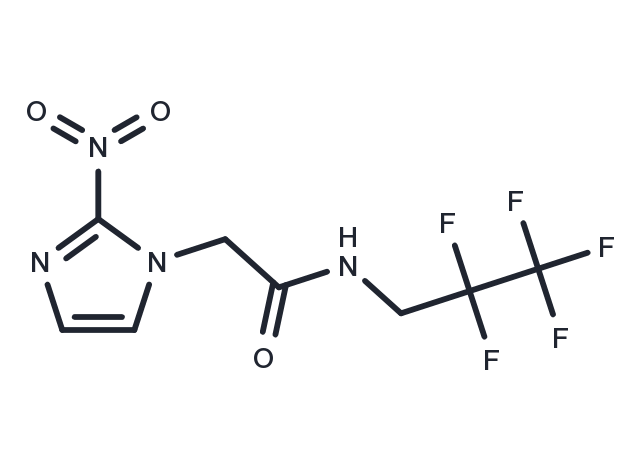Powder: -20°C for 3 years | In solvent: -80°C for 1 year


EF-5 (2-Nitroimidazole) is a agent of hypoxia labeling. It is used to identify hypoxia in cells.

| Pack Size | Availability | Price/USD | Quantity |
|---|---|---|---|
| 1 mg | In stock | $ 31.00 | |
| 5 mg | In stock | $ 72.00 | |
| 10 mg | In stock | $ 122.00 | |
| 25 mg | In stock | $ 247.00 | |
| 50 mg | In stock | $ 397.00 | |
| 100 mg | In stock | $ 589.00 | |
| 1 mL * 10 mM (in DMSO) | In stock | $ 79.00 |

| Description | EF-5 (2-Nitroimidazole) is a agent of hypoxia labeling. It is used to identify hypoxia in cells. |
| In vitro | EF-5 binding and metabolic reduction of the prodrugs are highly correlated in a panel of 14 hypoxic tumor cell lines. Overexpression of CYPOR causes similar 2- to 4-fold increases in EF-5 binding and metabolic reduction of tirapazamine and CEN-209 in SiHa and HCT116 cell lines. Which is similar enhancement of γH2AX formation.[1]. |
| In vivo | EF-5 binding is a promising stratification biomarker for benzotriazine-N-oxide bioreductive prodrugs. Binding and detection using a monoclonal antibody in 9L gliomas is specific and oxygen dependent, following intravenous injection of EF-5. Modification of tumor hypoxia causes similar changes to the bioreductive activation of both agents, resulting in a strong correlation between EF-5 binding and CEN209-induced DNA damage at the individual tumor level[1]. Detection of binding using fluorescence microscopy can be performed on frozen tissues; tissue sections can be counterstained with haematoxylin and eosin for light microscopic analysis. The distribution of hypoxia in a tumor can be inferred by examining individual tumor cells using flow cytometric techniques[2]. |
| Synonyms | 2-Nitroimidazole, EF5 |
| Molecular Weight | 302.16 |
| Formula | C8H7F5N4O3 |
| CAS No. | 152721-37-4 |
Powder: -20°C for 3 years | In solvent: -80°C for 1 year
DMSO: 125 mg/mL (413.69 mM), Sonication is recommended.
You can also refer to dose conversion for different animals. More
bottom
Please see Inhibitor Handling Instructions for more frequently ask questions. Topics include: how to prepare stock solutions, how to store products, and cautions on cell-based assays & animal experiments, etc.
EF-5 152721-37-4 Others 2-Nitroimidazole inhibit EF 5 EF5 Inhibitor inhibitor
